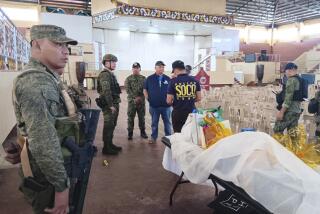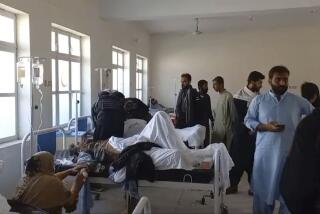Bomber Died in Church Blast, Pakistani Authorities Conclude
- Share via
ISLAMABAD, Pakistan — Investigators have concluded that the man who killed four Christian worshipers here blew himself up with high explosives and say the technically sophisticated assault suggests he had expert training.
Pakistani police supported by FBI agents arrested more than a dozen suspected members of Osama bin Laden’s Al Qaeda terrorist network in raids Thursday and are probing for possible links to the March 17 church attack, a senior Pakistani government official said Friday.
The blasts killed five people, including U.S. Embassy employee Barbara Green and her 17-year-old daughter, Kristen Wormsley. FBI and Pakistani investigators are now certain that the fifth, unidentified victim was the attacker, the source said.
In addition to the grenades the attacker threw at the worshipers, he was wired with a belt full of high explosives that were detonated with “a kind of pull switch,” the official said.
“It wasn’t done by an ordinary terrorist,” said the source, a top official in Pakistan’s anti-terrorism campaign who asked not to be identified because the investigation is continuing.
But he added, “We can’t say with certainty if there is any connection with Al Qaeda or another extremist group or some other agency.”
If the investigation does lead to Al Qaeda, it would make the Protestant church bombing the network’s first confirmed, successful terrorist attack since Sept. 11. Richard C. Reid, who is accused of a botched attempt to blow up an airliner with explosives in his shoes, is also suspected of being an Al Qaeda terrorist.
In Afghanistan, suspected Al Qaeda or Taliban fighters are known to have wired themselves with grenades to become walking bombs, ready to detonate if U.S. or other forces tried to arrest them.
Although Shiite and Sunni Muslim extremists have been attacking each other’s mosques for years in Pakistan, the attackers rarely use weapons any more complicated than assault rifles or a few grenades tossed through a door. The Protestant church attack was more complicated.
“It seems it has been carried out by some really, really expert handlers,” the Pakistani official said. “I personally feel that he came in as a ‘worshiper’ alongside the other people. He was very well-dressed, with trousers and formal shoes and a jacket and tie.”
FBI agents have taken a sample of the man’s DNA and his jacket for forensic testing in the U.S. to look for clues to his identity and nationality, and anything that might point to his sponsors, the source said.
Pakistani police also published a composite drawing of the suspect, a cleanshaven man in his early 20s, in local newspapers Thursday.
During the church service, the man went to a restroom close to an entry gate, took off his jacket and removed the pins from three of seven Russian-made grenades in the belt, the source said. The grenade pins were later found in the jacket pocket, he added.
The belt concealed as much as half a pound or more of high explosives, which detonated with a blast that caused much more damage than grenades would have. But the attacker “might not have known this was the fate he would meet,” speculated the Pakistani source, a military officer.
Bomber May Have Been Booby-Trapped
Investigators are concentrating on several clues suggesting that the terrorist might have been unknowingly booby-trapped rather than bent on suicide, a style of attack that is rare here.
The man threw one grenade to his right, another to his left and the third down the church’s center aisle, before a much larger explosion blew him up and caused extensive damage, the source said.
Each of the grenades was attached to the belt by threads, and a small cord linked the “pull switch” to a detonator on the high explosives. That suggests that the belt explosives went off when the attacker pulled off the fourth or fifth grenade, the Pakistani official said.
Even though the remaining four grenades would have been as close as an inch to the belt’s hidden explosives, they didn’t explode because the safety pins were still in place, he added.
Investigators are interrogating survivors, including Iranian, Iraqi and Afghan citizens who attended the service, to see if any are linked to the terrorist, the source said.
More than 65 people were arrested Thursday in raids on more than five sites in Faisalabad, Lahore and Multan. Two suspects were killed and two were injured. At least 28 of those detained were foreigners, most of whom are believed to be Al Qaeda members, Pakistani sources said.
Some of the Pakistanis detained belong to groups that President Pervez Musharraf banned as terrorist organizations in January, the source said.
He said Pakistani newspaper reports claiming that U.S. “commandos” participated in the raids were “absolutely false,” nor were FBI agents involved, he said. But a Pakistani Interior Ministry official said FBI agents had provided “technical assistance,” which he did not explain.
A large number of FBI agents are working in Pakistan and are easily spotted at Islamabad’s best hotel.
Although the anti-terrorism official said the FBI and Pakistani officials “have a good working relationship,” the presence of U.S. investigators here is a highly sensitive political issue, especially if they are heavily armed and directly involved in arrests, as local reports claimed Friday.
FBI agents are officially working on at least two criminal investigations in Pakistan: the church attack and the abduction and slaying of Wall Street Journal reporter Daniel Pearl in the port city of Karachi.
The trial of British-born Islamic extremist Ahmad Omar Saeed Sheikh, the prime suspect in Pearl’s killing, should begin April 5 with a formal reading of the indictment, a judge ordered at a hearing Friday.
For security reasons, the trial will be held inside Karachi’s main jail. It is scheduled to last a week.
Three other suspects will also face trial, and police say they are still searching for more people involved in the plot to kidnap Pearl, who was abducted Jan. 23 while investigating suspected links between “shoe bomber” Reid and Al Qaeda.
Sheikh’s father, Saeed Ahmad Sheikh, insisted that his son was innocent.
Saeed Ahmad Sheikh said his son rescued a woman in 1992 after she fell on a London railway line.
“He is a very proper type of a person,” Sheikh’s father told reporters before Friday’s hearing. “A person who has a record of saving someone’s life cannot take other lives.”
More to Read
Sign up for Essential California
The most important California stories and recommendations in your inbox every morning.
You may occasionally receive promotional content from the Los Angeles Times.













